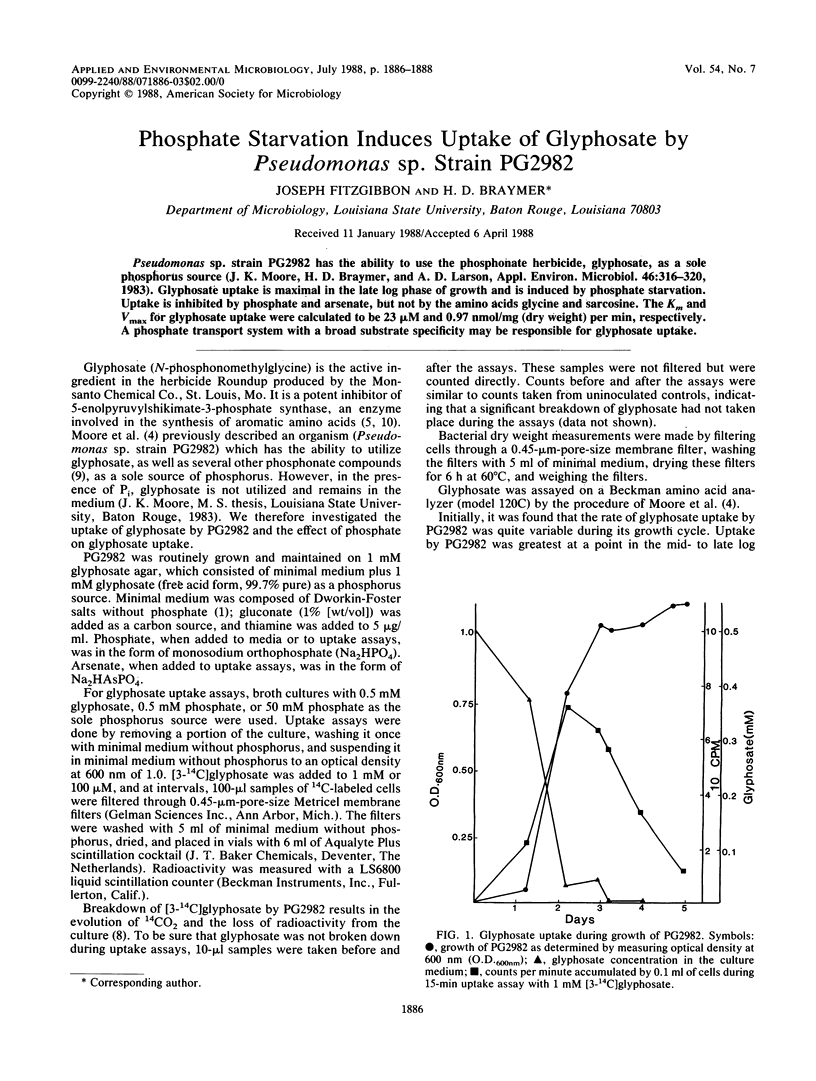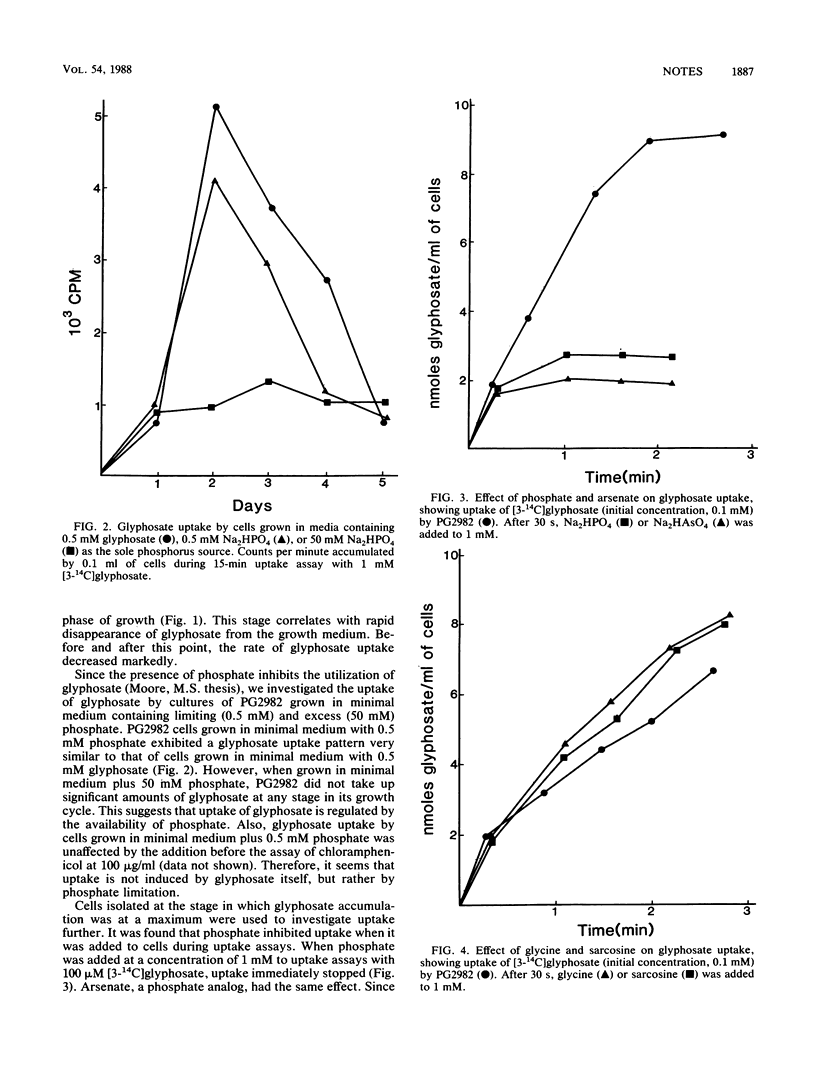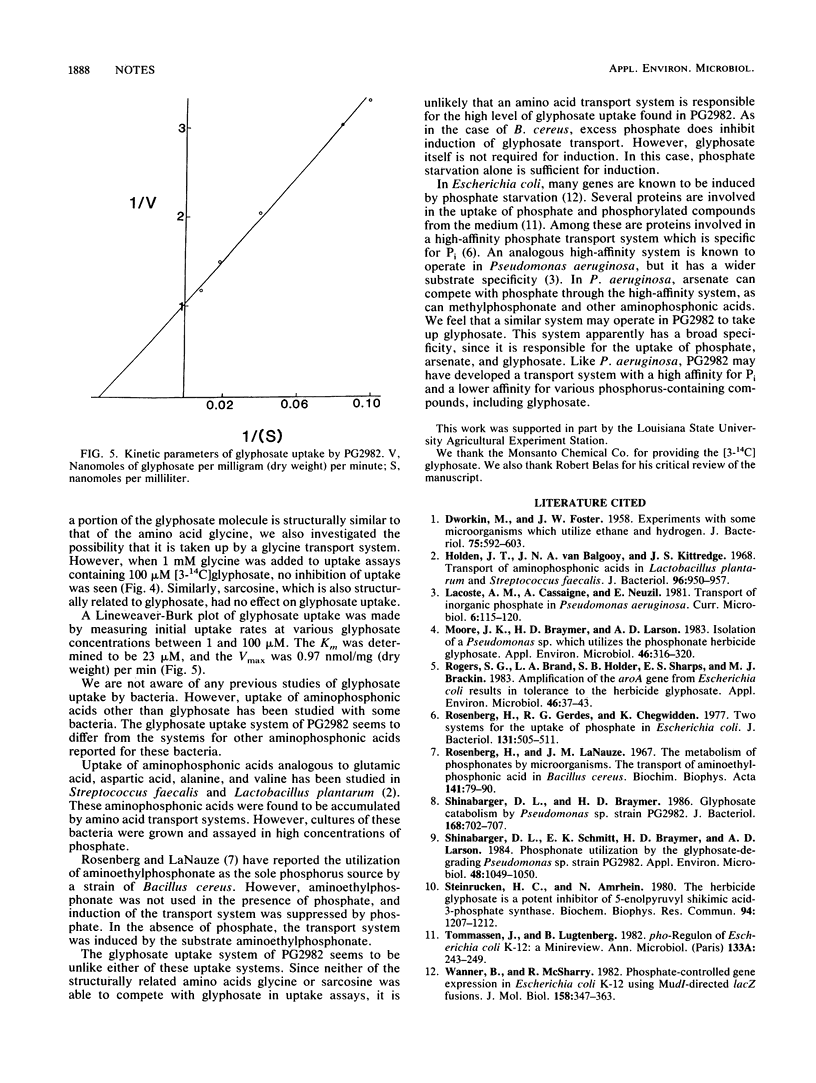Abstract
Pseudomonas sp. strain PG2982 has the ability to use the phosphonate herbicide, glyphosate, as a sole phosphorus source (J. K. Moore, H. D. Braymer, and A. D. Larson, Appl. Environ. Microbiol. 46:316-320, 1983). Glyphosate uptake is maximal in the late log phase of growth and is induced by phosphate starvation. Uptake is inhibited by phosphate and arsenate, but not by the amino acids glycine and sarcosine. The Km and Vmax for glyphosate uptake were calculated to be 23 microM and 0.97 nmol/mg (dry weight) per min, respectively. A phosphate transport system with a broad substrate specificity may be responsible for glyphosate uptake.
Full text
PDF


Selected References
These references are in PubMed. This may not be the complete list of references from this article.
- DWORKIN M., FOSTER J. W. Experiments with some microorganisms which utilize ethane and hydrogen. J Bacteriol. 1958 May;75(5):592–603. doi: 10.1128/jb.75.5.592-603.1958. [DOI] [PMC free article] [PubMed] [Google Scholar]
- Holden J. T., Van Balgooy J. N., Kittredge J. S. Transport of aminophosphonic acids in Lactobacillus plantarum and Streptococcus faecalis. J Bacteriol. 1968 Oct;96(4):950–957. doi: 10.1128/jb.96.4.950-957.1968. [DOI] [PMC free article] [PubMed] [Google Scholar]
- Moore J. K., Braymer H. D., Larson A. D. Isolation of a Pseudomonas sp. Which Utilizes the Phosphonate Herbicide Glyphosate. Appl Environ Microbiol. 1983 Aug;46(2):316–320. doi: 10.1128/aem.46.2.316-320.1983. [DOI] [PMC free article] [PubMed] [Google Scholar]
- Rogers S. G., Brand L. A., Holder S. B., Sharps E. S., Brackin M. J. Amplification of the aroA gene from Escherichia coli results in tolerance to the herbicide glyphosate. Appl Environ Microbiol. 1983 Jul;46(1):37–43. doi: 10.1128/aem.46.1.37-43.1983. [DOI] [PMC free article] [PubMed] [Google Scholar]
- Rosenberg H., Gerdes R. G., Chegwidden K. Two systems for the uptake of phosphate in Escherichia coli. J Bacteriol. 1977 Aug;131(2):505–511. doi: 10.1128/jb.131.2.505-511.1977. [DOI] [PMC free article] [PubMed] [Google Scholar]
- Rosenberg H., La Nauze J. M. The metabolism of phosphonates by microorganisms. The transport of aminoethylphosphonic acid in Bacillus cereus. Biochim Biophys Acta. 1967 Jun 13;141(1):79–90. doi: 10.1016/0304-4165(67)90247-4. [DOI] [PubMed] [Google Scholar]
- Shinabarger D. L., Braymer H. D. Glyphosate catabolism by Pseudomonas sp. strain PG2982. J Bacteriol. 1986 Nov;168(2):702–707. doi: 10.1128/jb.168.2.702-707.1986. [DOI] [PMC free article] [PubMed] [Google Scholar]
- Shinabarger D. L., Schmitt E. K., Braymer H. D., Larson A. D. Phosphonate Utilization by the Glyphosate-Degrading Pseudomonas sp. Strain PG2982. Appl Environ Microbiol. 1984 Nov;48(5):1049–1050. doi: 10.1128/aem.48.5.1049-1050.1984. [DOI] [PMC free article] [PubMed] [Google Scholar]
- Steinrücken H. C., Amrhein N. The herbicide glyphosate is a potent inhibitor of 5-enolpyruvyl-shikimic acid-3-phosphate synthase. Biochem Biophys Res Commun. 1980 Jun 30;94(4):1207–1212. doi: 10.1016/0006-291x(80)90547-1. [DOI] [PubMed] [Google Scholar]
- Tommassen J., Lugtenberg B. PHO-regulon of Escherichia coli K12: a minireview. Ann Microbiol (Paris) 1982 Mar-Apr;133(2):243–249. [PubMed] [Google Scholar]
- Wanner B. L., McSharry R. Phosphate-controlled gene expression in Escherichia coli K12 using Mudl-directed lacZ fusions. J Mol Biol. 1982 Jul 5;158(3):347–363. doi: 10.1016/0022-2836(82)90202-9. [DOI] [PubMed] [Google Scholar]


